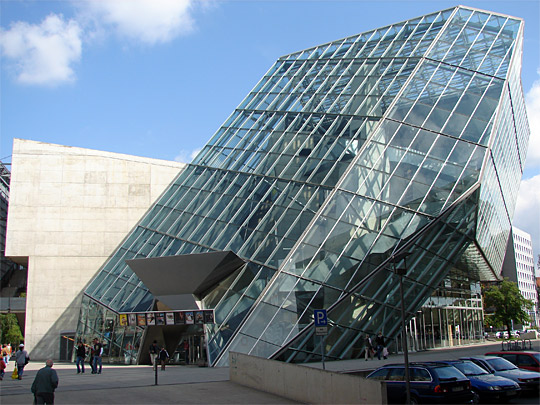Deconstructivism
Deconstructivism is a Postmodern architectural style characterised by the idea of fragmentation and the manipulation of a structure’s surface. Buildings adopting the style are often formed of components that have been disassembled and reassembled in a new and unorthodox way, giving the impression of a chaotic design devoid of precise logic.
It attempts to move away from the conventions of modernism that can be viewed as ‘constricting rules’, such as the notions that ‘form follows function’, ‘purity of form’, and ‘truth to materials’.
Deconstructivism in architecture was influenced by the deconstructivist theories of the French philosopher Jacques Derrida, who said that ‘architecture is nothing but one of many ways of communication’. It was also influenced by early-20th century constructivist architecture developed in Soviet Russia.
Deconstructivism developed out of the postmodern style and first gained widespread attention in 1988 with an exhibition entitled ‘Deconstructivist Architecture’ in New York’s Museum of Modern Art. The exhibition featured the work of architects such as Frank Gehry, Rem Koolhaas and Zaha Hadid. Where deconstructivism deviates from the postmodernist style in its rejection of ornament as decoration.
Other defining stylistic features include:
- Unrelated forms.
- Abstract nature.
- Smooth exterior surfaces.
- Contrast of shapes and forms.
- Large expanses of a single material (glass, metals, masonry, etc.).
- Window frames often hidden in the walls.
- Simple metal frame doors.
- Exposed materials.
The rise in prominence of computer-aided design (CAD) in contemporary architecture was a key factor in the development of deconstructivism, as three-dimensional modeling enabled the intricate design of complicated and unorthodox shapes and spaces.
Despite seeking to distance himself from the label, one of the most prominent architects associated with the style is Frank Gehry, whose Santa Monica residence – the building for which he first received critical acclaim – is regarded as the prototypical deconstructivist building, as well as his later buildings the Guggenheim Museum and Walt Disney Concert Hall.
Other architects who have been identified with the style are Zaha Hadid, Peter Eisenman, Rem Koolhaas, and Daniel Libeskind.
The most notable examples of deconstructivism are:
- CCTV Headquarters, Beijing.
- Dancing House, Prague.
- Imperial War Museum, Manchester.
- Guggenheim Museum, Bilbao.
- Jewish Museum, Berlin.
- Walt Disney Concert Hall, Los Angeles.
[edit] Related articles on Designing Buildings Wiki
- Architectural styles.
- Art Deco.
- Art Moderne.
- Art Nouveau.
- Bauhaus.
- BEST Products showrooms.
- Blobitecture.
- Brutalism.
- Chinese brutalism.
- Computer aided design (CAD).
- Concept architectural design.
- Constructivist architecture.
- Dancing House, Prague.
- Frank Gehry.
- Guggenheim Museum, Bilbao.
- High-tech architecture.
- Italian brutalism.
- Metabolism.
- Peter Eisenman.
- Parametricism.
- Postmodern architecture.
- Spomeniks.
- Walt Disney Concert Hall.
- Zaha Hadid.
[edit] External references
Featured articles and news
Moisture, fire safety and emerging trends in living walls
How wet is your wall?
Current policy explained and newly published consultation by the UK and Welsh Governments.
British architecture 1919–39. Book review.
Conservation of listed prefabs in Moseley.
Energy industry calls for urgent reform.
Heritage staff wellbeing at work survey.
A five minute introduction.
50th Golden anniversary ECA Edmundson apprentice award
Showcasing the very best electrotechnical and engineering services for half a century.
Welsh government consults on HRBs and reg changes
Seeking feedback on a new regulatory regime and a broad range of issues.
CIOB Client Guide (2nd edition) March 2025
Free download covering statutory dutyholder roles under the Building Safety Act and much more.
AI and automation in 3D modelling and spatial design
Can almost half of design development tasks be automated?
Minister quizzed, as responsibility transfers to MHCLG and BSR publishes new building control guidance.
UK environmental regulations reform 2025
Amid wider new approaches to ensure regulators and regulation support growth.
The maintenance challenge of tenements.
BSRIA Statutory Compliance Inspection Checklist
BG80/2025 now significantly updated to include requirements related to important changes in legislation.
Shortlist for the 2025 Roofscape Design Awards
Talent and innovation showcase announcement from the trussed rafter industry.























